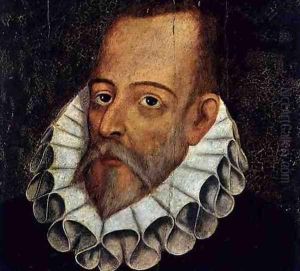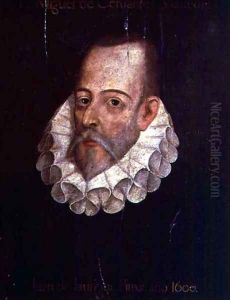Juan de Jauregui y Aguilar Paintings
Juan de Jáuregui y Aguilar, born in 1583 in Seville, Spain, was an artist and poet of the Spanish Golden Age, a period renowned for flourishing arts and literature in Spain. His life and work are emblematic of the intense cultural and artistic activities that characterized this era. Jáuregui's talents were multifaceted, encompassing painting, poetry, and literary translation, which positioned him as a significant figure among his contemporaries.
Jáuregui's artistic endeavors were primarily focused on painting, and though his body of work is not extensively documented, he is particularly noted for his portraits and religious subjects. His style reflects the influence of the Italian Renaissance and Baroque movements, which were dominant in European art at the time. This influence is evident in his use of dramatic lighting, precise anatomical detail, and dynamic composition. Despite the scarcity of his surviving works, Jáuregui is reputed to have been a master of technique and expression, qualities that earned him recognition and commissions from the church and nobility.
In addition to his visual art, Jáuregui made significant contributions to Spanish literature. He was an accomplished poet and translator, known for his translation of Torquato Tasso's epic poem 'Jerusalem Delivered,' which had a considerable impact on Spanish literary culture. His poetic works, though less known today, were celebrated for their elegance and linguistic skill. Jáuregui's literary output reflects the intellectual vibrancy of his time, engaging with themes of religion, philosophy, and the human condition.
Jáuregui's life and work were deeply intertwined with the cultural milieu of Seville, a city that was a vibrant center for the arts during the Spanish Golden Age. His contributions to both the visual and literary arts demonstrate the interdisciplinary nature of this period's cultural production. Unfortunately, detailed records of his life, including specific commissions and personal anecdotes, are limited, which has led to some ambiguity regarding his biography and the full extent of his oeuvre.
Juan de Jáuregui y Aguilar died in 1641, leaving behind a legacy that, despite the relative obscurity of some of his work, positions him as a noteworthy figure in the history of Spanish art and literature. His life exemplifies the rich cultural ferment of early modern Spain, and his work contributes to our understanding of the era's artistic and intellectual achievements.

